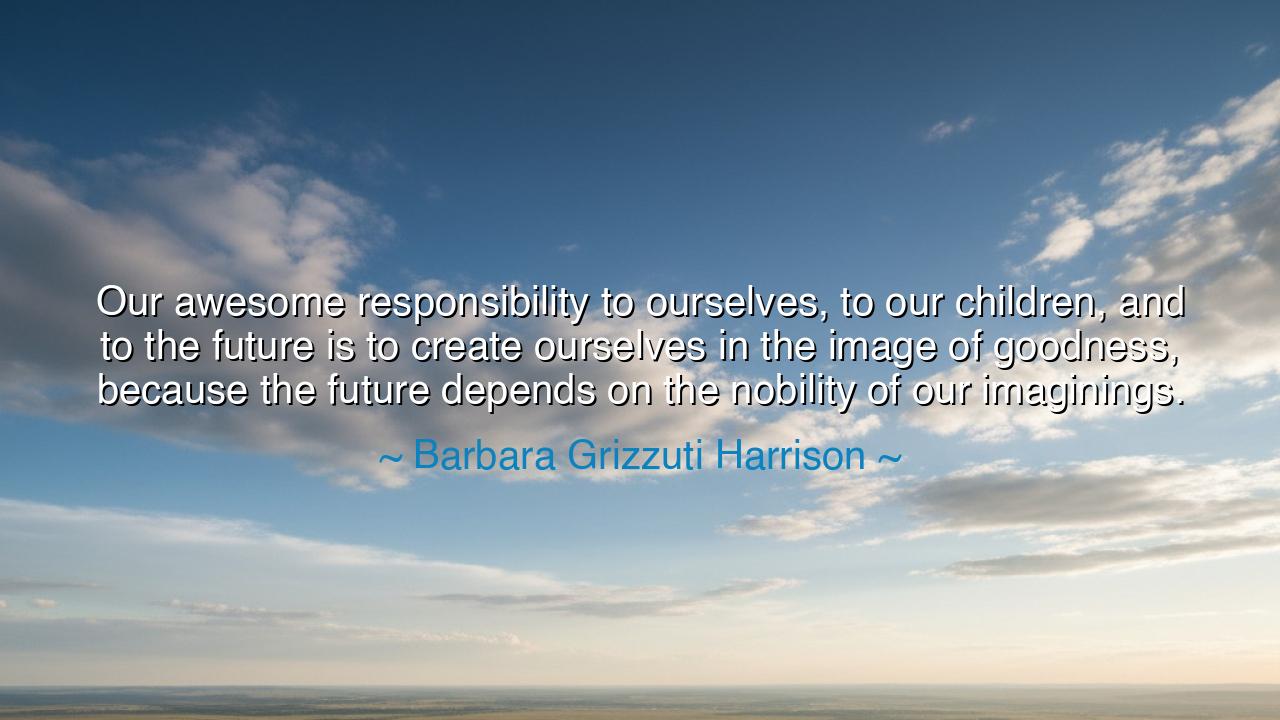
Our awesome responsibility to ourselves, to our children, and to
Our awesome responsibility to ourselves, to our children, and to the future is to create ourselves in the image of goodness, because the future depends on the nobility of our imaginings.






"Our awesome responsibility to ourselves, to our children, and to the future is to create ourselves in the image of goodness, because the future depends on the nobility of our imaginings." These profound words by Barbara Grizzuti Harrison challenge us to recognize the immense responsibility we hold—not only to ourselves but to the generations that follow. Harrison’s insight speaks to the idea that goodness, not just for the sake of personal morality, but for the sake of future progress, must be the guiding force in our actions. The nobility of our imagining, our visions of what the world could become, shapes the legacy we leave behind and sets the course for the world our children will inherit. The very future of humanity, Harrison suggests, is deeply rooted in the moral fiber and imagination of those who live today.
In the ancient world, the concept of responsibility to the future was often intertwined with the idea of legacy and virtue. Plato, in his writings, often emphasized the importance of creating a just society based on the wisdom and virtue of its citizens. In his Republic, he presents the ideal of individuals shaping not only their own lives but the society around them, in a way that fosters goodness and justice for future generations. Just as Plato believed in the power of the individual to shape the world, Harrison too reminds us that our actions today—how we live and how we imagine the future—have far-reaching consequences.
Consider the story of King Ashoka, the ruler of the Indian Maurya Empire in the 3rd century BCE. Ashoka’s early reign was marked by violence and conquest, but after witnessing the horrors of war, he turned to Buddhism and embraced a path of non-violence and compassion. His transformation led him to promote not just his own personal sense of goodness, but the creation of a society based on ethical principles, compassion, and the well-being of future generations. Ashoka’s actions were a testament to the power of imagining a future defined by peace and goodness—one where society could flourish under the values of kindness and justice. His legacy is an example of how personal growth and noble imaginings can shape a world that transcends the mistakes of the past.
Similarly, Mahatma Gandhi saw the future as shaped by the morality and vision of those in power, but also by the actions of individuals. Gandhi’s famous commitment to nonviolence and truth stemmed from his belief in the goodness of human potential. He didn’t just imagine a future free from colonial oppression; he actively sought to create that future through peaceful resistance and the nobility of his actions. His imaginings were grounded in the idea that the future would be shaped by those who chose goodness, not just for themselves but for the collective wellbeing of society. In this way, Gandhi exemplified how the future can be influenced by those who live according to noble principles and act with intentional goodness.
In the modern era, the concept of responsibility to future generations is perhaps best exemplified by environmentalists who have made it their life’s work to ensure that the planet is preserved for the sake of future inhabitants. Rachel Carson, in her groundbreaking work Silent Spring, warned the world about the dangers of unchecked industrial progress, calling on humanity to imagine a future where nature and humanity coexist in balance. Carson’s vision of a world in harmony with nature was not merely an environmentalist dream, but a call to create a sustainable future that would nurture generations to come. Much like Harrison’s quote, Carson’s work demonstrated that the nobility of our imagining shapes the world we leave behind.
The lesson in Barbara Grizzuti Harrison's words is one of moral responsibility and vision. To create a good future, we must start by fostering goodness in the present—by shaping ourselves, our communities, and our societies in the image of virtue, compassion, and justice. Our imaginings of the future must be filled with the hope of progress and the belief that humanity can reach its highest potential. To imagine a future rooted in goodness is not merely an act of fantasy, but a call to action, to live in such a way that we can look back and know we have shaped a better world for those who come after us.
In practical terms, this means taking intentional steps every day to live virtuously—whether in how we treat others, how we engage with the environment, or how we contribute to the world around us. It also means nurturing the imagination of younger generations, teaching them not only the value of knowledge but the importance of goodness and empathy. Let us be active in shaping a world where the imagination of the future is filled with possibility, but also with a commitment to noble and virtuous living. Just as Ashoka and Gandhi shaped their worlds through their actions, so too must we shape the future with our own. Let us remember that the future depends on the nobility of our imaginings, and those imaginings must be grounded in a commitment to goodness.






AAdministratorAdministrator
Welcome, honored guests. Please leave a comment, we will respond soon